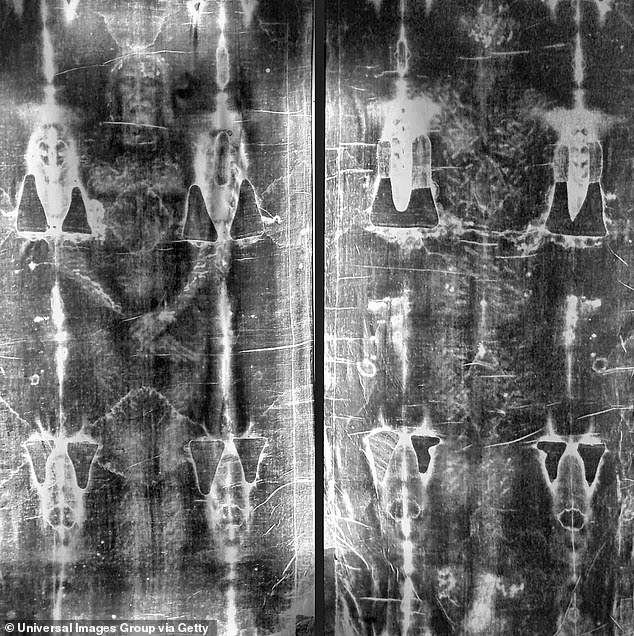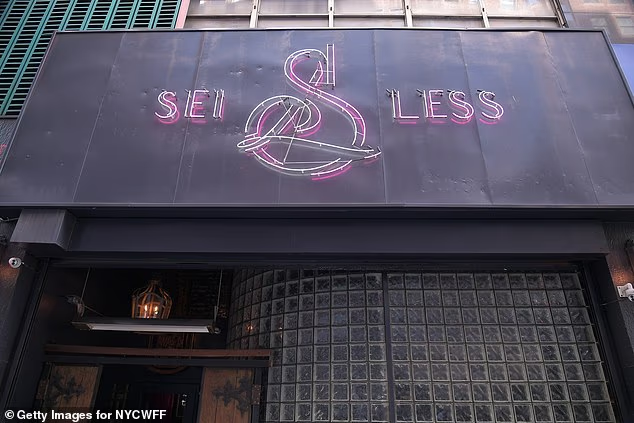A theologian who once dismissed the Shroud of Turin as a hoax now says he’s uncovered stunning evidence that made him a believer.
The 14-foot linen cloth, faintly imprinted with the negative image of a crucified man, is believed by millions to be the burial shroud of Jesus Christ.
Dr Jeremiah Johnston, who earned his PhD at Oxford, told the Daily Mail he was long conditioned to view the relic as a medieval forgery, a belief rooted in a 1988 study that dated a corner sample of the fabric between 1260AD and 1390AD, centuries after Christ’s crucifixion.
‘There are actual videos out there where I’m being interviewed and I give very high-brow responses about the relic,’ he said. I say that to my own shame, because I had never actually studied the Shroud for myself.’
It was not until Johnston began reading the many peer-reviewed studies on the Shroud, specifically one in 1978 that found the image is not from an artist, but a real human form of a scourged and crucified man.
The Shroud of Turin Research Project (STURP) team used X-rays, ultraviolet and infrared photography, chemical analysis and microscopic tests to study the cloth’s fibers, stains and image.
‘They found that this shroud is not man-made. There’s no pigment, there’s no dye, there’s no paint,’ Johnston said.
‘They confirmed that the shroud cannot be traced back to a human origin.’
The Shroud of Turin, housed in Italy, is a 14-foot linen cloth, faintly imprinted with the negative image of a crucified man, is believed by millions to be the burial shroud of Jesus Christ
STURP involved 33 American scientists from various institutions, including forensic scientists, biochemists and physicists, including Dr John Jackson and Dr Eric Jumper from the US Air Force Academy.
Jackson and Jumper first became interested in the Shroud in 1976, when they used a NASA-developed VP-8 Image Analyzer to study photographs of the cloth and discovered its unique three-dimensional image properties.
AVP-8 Image Analyzer is a device used in space probes to acquire accurate 3D images of celestial objects.
‘The results showed the Shroud had a holographic quality to it, meaning that there was 3D information encoded in the cloth that gave it a brightness map,’ said Johnston.
‘Literally, there was a depth. They could see the variations in brightness and this kind of distance information.’
Their findings led them to organize the full STURP expedition to Turin, where the team conducted extensive tests on the Shroud’s fibers, stains and image.
About two years later, the team found themselves in Turin, Italy, where the cloth is housed, and took the opportunity to study it firsthand.
The team collected samples using adhesive tape to analyze the cloth, collecting a total of 32, along with 18 from the image areas and 14 from non-image areas.

Dr Jeremiah Johnston, who earned his PhD at Oxford, told the Daily Mail he was long conditioned to view the relic as a medieval forgery, but after doing his own researchers is now a believer it is the burial cloth of Jesus

The Shroud of Turin Research Project (STURP) team used X-rays, ultraviolet and infrared photography, chemical analysis and microscopic tests to study the cloth’s fibers, stains and image (pictured)
The samples, which came from bloodstains, contained hemoglobin, a protein found in red blood cells, and tested positive for serum albumin.
Serum albumin is a protein found in the blood that plays an important role in maintaining fluid balance, transporting substances and protecting organs.
‘The scientific consensus is that the image was produced by something which resulted in oxidation, dehydration and conjugation of the polysaccharide structure of the microfibrils of the linen itself,’ the STURP team concluded.
‘Such changes can be duplicated in the laboratory by certain chemical and physical processes.
‘A similar type of change in linen can be obtained by sulfuric acid or heat. However, there are no chemical or physical methods known which can account for the totality of the image, nor can any combination of physical, chemical, biological or medical circumstances explain the image adequately.’
When asked why this research does not hold as proving the shroud’s authenticity, Johnston said: ‘You have a lot of skeptics who are Bible scholars. They don’t go to church. They don’t follow Jesus.
‘So there’s a built-in skepticism, but also, honestly, academics become so siloed, they become so specialized, that they do not read widely.’

The 1978 identified blood proteins in the Shroud, concluding is not man-made
He explained that the Shroud deemed a medieval forgery in headlines was so ubiquitous.
The team of the 1988 study sampled the top left corner of the cloth, which later studies determined was not representative of the original cloth but was instead a medieval repair.
‘The Shroud has been examined across 102 different academic disciplines,’ he explained,’ said Johnston.
‘I’m a New Testament historian who specializes in the historical Jesus, that’s my field, but when you combine my expertise with 101 others, it’s remarkable.
‘Altogether, more than 600,000 hours of peer-reviewed academic research have gone into studying the Shroud.
‘That’s why it’s often described in scholarly journals as the single most researched archaeological artifact in the world.’
He added that thanks to thinkers who are now following the evidence where it leads, the tides are turning.
‘It’s not a hoax, it’s the actual burial cloth of Jesus,’ Johnston said. ‘I’ve met the researchers, heard their stories, and seen their evidence, and I find it compelling.
‘That’s why I often ask people, ‘How much proof do you really need before you believe something is authentic?”
By
Source link




Leave a Reply